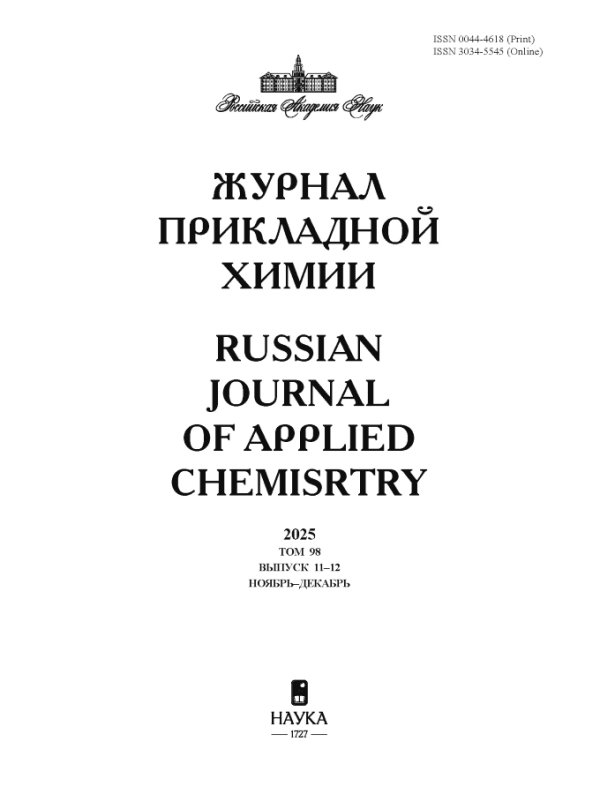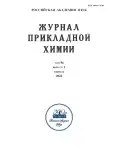Esters of Inulin and Tall Oil Fatty Acids
- Authors: Kurzin A.V.1, Evdokimov A.N.1, Il'ina N.S.2
-
Affiliations:
- St. Petersburg State University of Industrial Technologies and Design
- ITMO University
- Issue: Vol 96, No 2 (2023)
- Pages: 147-150
- Section: Articles
- URL: https://journals.rcsi.science/0044-4618/article/view/247272
- DOI: https://doi.org/10.31857/S0044461823020020
- EDN: https://elibrary.ru/OUDKWG
- ID: 247272
Cite item
Full Text
Abstract
The possibility of obtaining polysaccharide esters based on large-scale products of plant origin: inulin and tall oil fatty acids, was studied. Carbohydrate esters of the biopolymer inulin and higher unsaturated acids were synthesized by acylation with acid chlorides under various conditions: in a water–chloroform mixture in the presence of sodium hydroxide and sodium salts of tall oil fatty acids, as well as in a pyridine–1,4-dioxane mixture. The yield of polysaccharide esters was 67–82%, the maximum yield was detected during the acylation of inulin in the pyridine–1,4-dioxane system
Keywords
About the authors
A. V. Kurzin
St. Petersburg State University of Industrial Technologies and Design
Email: acjournal.nauka.nw@yandex.ru
191186, St. Petersburg, Russia
A. N. Evdokimov
St. Petersburg State University of Industrial Technologies and Design
Email: acjournal.nauka.nw@yandex.ru
191186, St. Petersburg, Russia
N. S. Il'ina
ITMO University
Author for correspondence.
Email: acjournal.nauka.nw@yandex.ru
197101, St. Petersburg, Russia
References
- Ahmad M. U., Xu X. Polar lipids: Biology, chemistry, and technology. Urbana: AOCS Press, 2015. P. 215-243. https://doi.org/10.1016/C2015-0-02381-4
- Tracy P., Dasgupta D., More S. Challenges and opportunities for production of C5 sugar fatty acid esters (SFAEs) from renewable resources // Ind. Crops Prod. 2023. V. 193. ID 116170. https://doi.org/10.1016/j.indcrop.2022.116170
- Bhanja A., Sutar P. P., Mishra M. Inulin-A Polysaccharide: Review on its functional and prebiotic efficacy //j. Food Biochem. 2022. V. 46. N 12. e14386. https://doi.org/10.1111/jfbc.14386
- Mensink M. A., Frijlink H. W., van der Voort Maarschalk K., Hinrichs W. L. J. Inulin, a flexible oligosaccharide I: Review of its physicochemical characteristics // Carbohydr. Polym. 2015. V. 130. P. 405-419. https://doi.org/10.1016/j.carbpol.2015.05.026
- Stevens C. V., Meriggi A., Booten K. Chemical modification of inulin, a valuable renewable resource, and its industrial applications // Biomacromolecules. 2001. V. 2. N 1. P. 1-16. https://doi.org/10.1021/bm005642t
- Головин А. И., Трофимов А. Н., Узлов Г. А., Жукова И. П., Киприанов А. И., Прохорчук Т. И., Ковалев В. Е. Лесохимические продукты сульфатцеллюлозного производства. М.: Лесн. пром-сть, 1988. С. 64-68.
- Evdokimov A. N., Kurzin A. V., Popova L. M., Franchuk V. B. Purification of tall oil fatty acids by removing of stilbenes // Eur. J. Wood Prod. 2021. V. 79. N 4. P. 1027-1029. https://doi.org/10.1007/s00107-021-01663-9
- Wang S.-F., Furuno T., Cheng Z. Synthesis of new amino acid-type amphoteric surfactants from tall oil fatty acid //j. Wood Sci. 2001. V. 47. N 6. P. 470-475. https://doi.org/10.1007/BF00767900
- Торлопов М. А., Удоратина Е. В., Кучин А. В. Синтез эфиров инулина и фенолкарбоновых кислот // ЖОрХ. 2013. Т. 49. № 5. С. 719-723. EDN: PZEQTP
- Курзин А. В., Евдокимов А. Н., Павлова О. С., Антипина В. Б. Эфиры амилозы, целлюлозы и жирных кислот таллового масла // ЖПХ. 2008. Т. 81. № 12. С. 2068-2069. EDN: KFSREZ
Supplementary files










